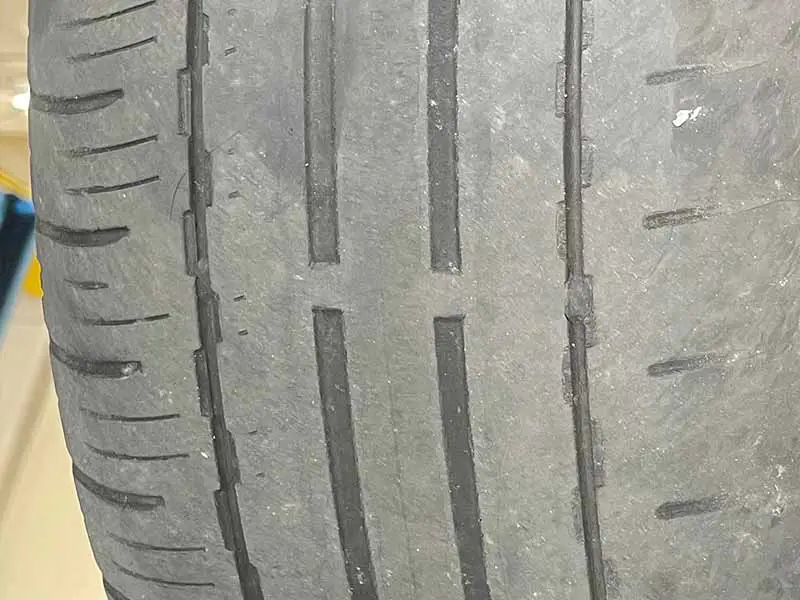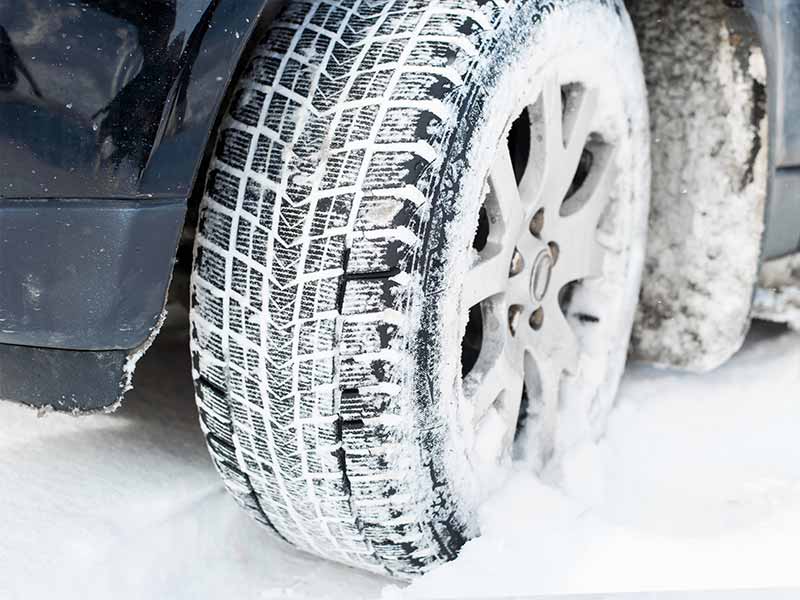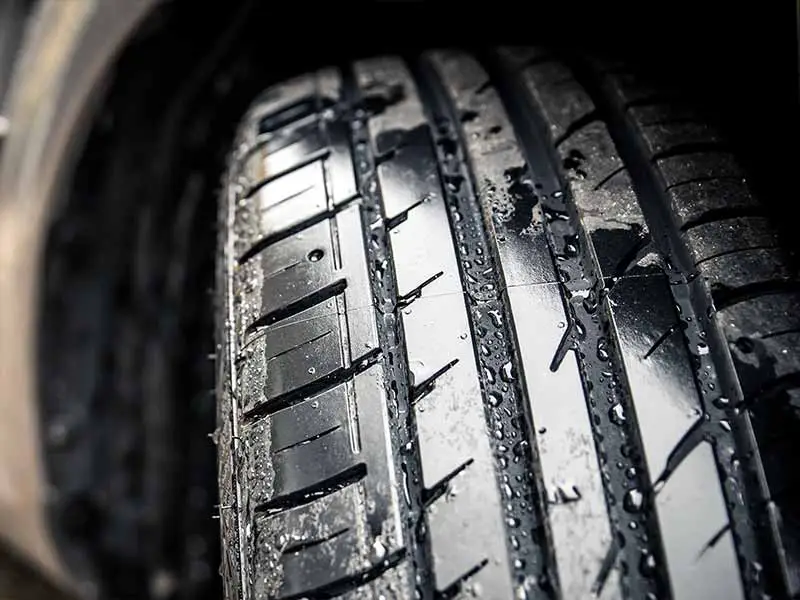It’s recommended that you check tire tread depth regularly. A tire tread depth gauge is the most accurate method to check your tire tread, but you can use a quarter or penny as well as just a visual inspection of the wear bars to get an estimate of how close your tires are to needing to be replaced.
What Is Tire Tread Depth
Tire tread depth is the vertical measurement of the surface of the tread block to the bottom of the tread groove. Tire tread is responsible for channeling water away from beneath your tires so you can maintain traction and reduce the chances of hydroplaning.
New tires for passenger cars and trucks typically have 10/32″ to 11/32″ of tread depth. It’s recommended that tires be replaced once the tread has worn to 4/32″ of remaining depth. The legal minimum in most states is 2/32″.
It’s important to perform regular tire maintenance to avoid uneven tread wear, good traction on wet roads, and long tread life.
Let’s take a closer look.
Importance Of Tread Depth
Tread depth is crucial to channel water out from underneath the contact patch of your tires. Tire performance in wet conditions depends upon the tire’s tread depth.
As your tires approach lower tread depths, the tread grooves that allow water to flow away from underneath your tires get smaller and less efficient and allowing water to move as quickly away.
Tires that have worn down to 4/32″ will have as much as 50% longer stopping distances than new tires when panic braking in rainy weather. Once tires have worn down to the minimum tread depth of 2/32″, emergency wet stopping distances will have increased as much as another 50%. That’s twice the distance of new tires.
How To Measure Tread Depth with A Gauge
A tire tread depth gauge is a simple tool that is specifically designed to measure tread depth. The gauge has a wide base to it, and a narrow probe that hangs below the base.
Tread depth is measured in increments of 1/32 inch. This is quite a small increment and not practical to measure with a ruler. This is what makes a specially-designed gauge ideal. The precision required and the convenience of a tool that is small enough to be placed in a tread groove while still mounted on your car or truck.
- Place the gauge on top of your tire. The narrow probe needs to be centered so that it will push on the base of your tread. In other words, it should land between two treads. You need to measure from the main large and deep tread grooves and not smaller and shallower parts of the tread pattern.
- Push down on the top of the gauge until the base of the measuring pin is pushing on your tire at the base of the tread and the broad base of the gauge is sitting on top of the tread blocks.
- Remove the gauge slowly without hitting the pin or indicator at all. Read the indicator to see the tire’s tread depth.
- Repeat this process another two times and average the three readings together. This average will tell you what your total tire tread depth is. You will also need to do this on all four tires to get a full picture of your tire health.
How To Measure Tread Depth with A Penny (Or Quarter)
If you don’t want to use a tread depth gauge, you can reach into your pocket and find a penny or quarter. Oddly enough, these two coins can tell you the health of your tires, just like a tread depth gauge would.
This method won’t tell you how much tread you have left, but it works like a go/no-go check. In other words, it will only tell you if you have a safe level of tread depth or not.
Here’s how it works:
- Grab a penny and hold it so Lincoln is facing you and upside down. You should be looking at the head’s side of the coin with the image upside down. While holding the penny just like this, put it into your tire’s tread groove (between two pieces of tread).
- If you can see the entirety of Lincoln’s head, then your tread is not deep enough. Seeing his head means that it’s time to change your tires. It also roughly equates to 1/16 (2/32) of an inch of tread that you have left, which is not safe.
- If you hold a quarter in the exact same fashion and do the same test, you’ll know how close your tires are to needing replacement. Washington’s head is about 1/8 (4/32) of an inch away from the edge of a quarter. If you can see his full head, then you have less than 1/8 inch of tread.
Wear Bars
Wear bars are small bumps located at the bottom of the tread grooves of most tires that are used as tread wear indicators. The wear bars are only 2/32″ above the bottom of the tread groove which matches the minimum tread depth.
Once your tires have worn down to even with the wear bars, you know it’s time to replace your tires.

Minimum Tire Tread Depth
According to the Department of Transportation (DOT), you should change your tires when the treads are less than 2/32 of an inch deep.
This is considered the minimum depth that you should ever drive on. If you try driving will less tread than this, you run a high risk of spinning out, losing control, and taking too long to come to a complete stop.
Safe Tire Tread Depth
On the other hand, there is also the depth that most experts consider “safe”. This occurs sooner than the minimum tire tread depth. Replacing your tires when they hit the “safe” tread and before the “minimum” tread will keep you safer and help your car’s performance.
Most experts will suggest that you swap your tires when they hit 4/32” of tread depth. This is double the thickness of the minimum legal tread depth in most states.
By changing your tires sooner, you’ll enjoy have significantly shorter stopping distances when panic braking on wet roads and less risk of hydroplaning. The difference in performance on wet roads between 4/32″ and 2/32″ can be 50% longer.
With this small amount of tread wear remaining, the difference in safety versus the small amount of potential savings isn’t worth the risk of driving longer on worn tires.
Tread Depth to Replace Tires
It’s worth mentioning that replacing your tires might happen before the treads get down to a certain depth. If you notice uneven wearing, tire damage, bulging, or a puncture in your tire, you might have to change it regardless of the tire’s tread depth.
Even without tire damage, you’ll need to replace your tires once they get to a certain depth.
We would suggest that you change your tires any time they get down to 4/32”. It’s not worth the added risk to keep driving until they hit the 2/32” figure that the DOT points out. Finding the exact depth requires a tread depth gauge, but using a coin like a Washington quarter or a penny as a gauge can give you a ballpark idea of when you should replace tires.
Even at 4/32 of an inch, your stopping distance will be somewhere around 50% further than if you tried stopping on brand-new tires. At 2/32 of an inch, your stopping distance is about twice the distance. It’s not worth the extra risk.
Winter Tire Tread Depth
Winter tires are a little different. If you didn’t know, winter tires are specifically designed to drive through snow and ice better than a standard tire could.
To improve traction in winter driving conditions, winter tires use different tread pattern designs and the tread blocks contain slits known as sipes that improve grip in slush, snow, and even on ice.
Winter tires also use softer rubber compounds that will remain soft in freezing temperatures. For this reason, winter tires shouldn’t be used in temperatures above 40º F. The rubber will be too soft and wear down very quickly.
Tread depths are also deeper to allow the tread blocks to penetrate through the slush and snow down to the road surface. This means that winter tires should be replaced when they tires wear down to 4/32″ or even sooner.

Extending Tire Life
Good tire maintenance will help you keep your tires wearing evenly and lasting as long as possible. Let’s go over the basics of keeping your tires in great shape:
Tire Maintenance
• Check tire pressures match those listed in the driver’s door jamb
• Inspect tires for uneven wear and damage
• Ensure tread depth is 4/32″ or greater
• Rotate tires every 5,000 miles
• Balance and align every 10,000 miles
Tread Depth of New Tires
The science behind changing your tires stems from the overall percentage of usable treads. In that case, it’s important to understand how much tread your tires start with.
Commercial vehicles, larger trucks, and big SUVs typically have deeper treads because, with the added weight, the tire tread wears quicker.
The tread depth also varies tremendously on the other side of the scale. High-performance options and tires suitable for the track might have very little tread. If you look at an F1 car, you’ll notice that they don’t have any tread at all.
Ignoring these outliers, most tires come with the same level of tread.
Most brand-new tires will start with 10/32” or 11/32” of tire depth. By the time the DOT says you must change your tires, they’ve worn down to 2/32″ of remaining tread, which is scary when you think about it.
Resources
Below are some links you may find helpful when learning about tires
Final Thoughts
Checking the depth of your tire’s tread and replacing your tires once they have worn to 4/32″ of tread remaining is important to safe driving in wet weather.
Even though most states allow tires to have as little as 2/32″ of tread remaining, it isn’t recommended that you wait that long since stopping distances on wet surfaces can more than double that of new tires.
Good luck and happy motoring.





